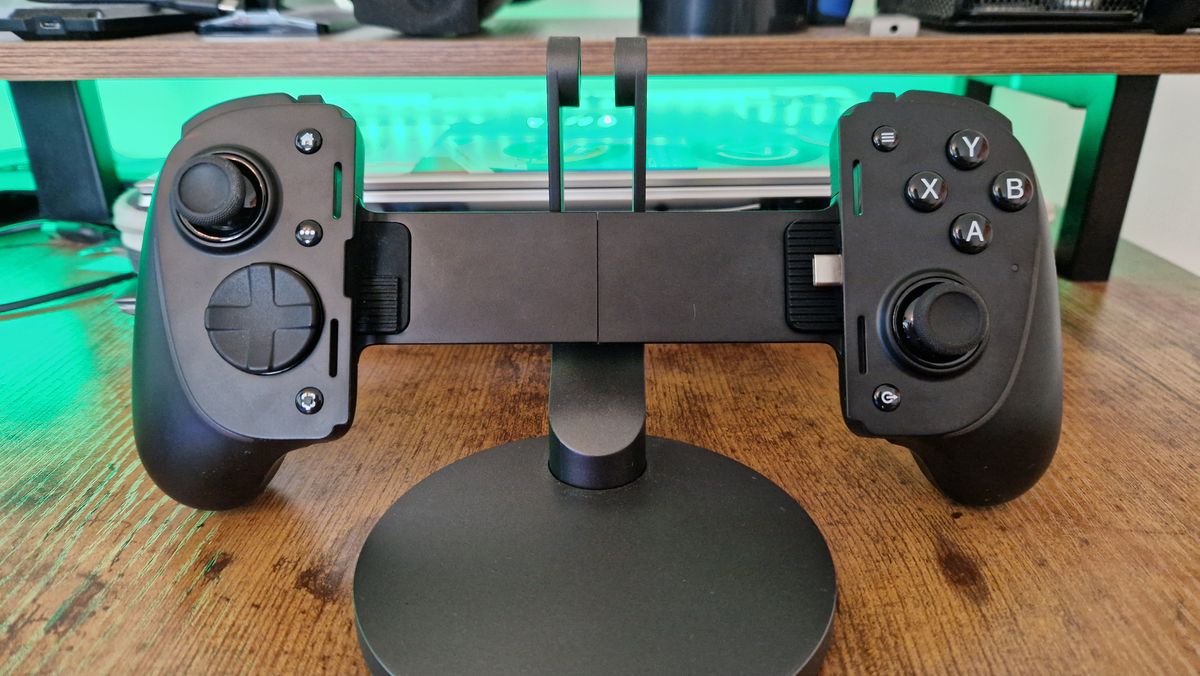12DOVE Verdict
The Razer Kishi Ultra is probably the most comfortable mobile controller out there, but that doesn’t automatically make it the best. Its price is inexplicably high, and for some reason, it opts for additional bumpers instead of back buttons. While it will understandably be the cream of the crop for a lot of large-handed mobile gamers, it’s been blindsided by a budget alternative that offers more utility for less money.
Pros
- +
Substantial, full-sized controller grips
- +
Tactile buttons
- +
Great triggers
- +
Versatile size
- +
Flashy RGB look
Cons
- -
Extra bumpers, no back buttons
- -
USB-C connector doesn’t pivot
- -
No PS5 remote play support
- -
Pricey
Why you can trust 12DOVE
The Razer Kishi Ultra is exactly the type of mobile controller I want manufacturers to make. It isn’t trying to be cute, it isn’t some dumbed-down version of the full-sized gamepads they already make. It’s one of their existing pro controllers sawed in half and tweaked to suit a portable device.
More and more, this is the design philosophy the best mobile controllers are gunning for, and they’re all the better for it. There’s no denying that the Backbone One started a mobile gaming revolution, but with every new rival that’s arrived to compete with it, the more basic it’s ended up looking. For those who find the Backbone too small, too scaled back, the Razer Kishi Ultra offers a full-sized alternative.
For what Razer is calling the god-tier of mobile gaming though, it does set you back a lot. $149.99 / £149.99 is an investment a lot of people would struggle to justify for an at-home gaming controller, let alone one for their phone. Unfortunately, while this is so close to being the best option on the market, that price is just one of many reasons I’d recommend the GameSir G8 Galileo instead.
Design
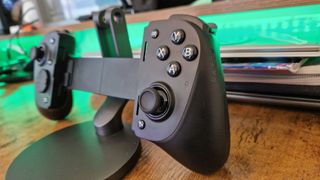
The Razer Kishi Ultra reminds me more of one of the best PC controllers than any other mobile controller I’ve used. To get specific, it feels more like a successor to the Wolverine family than it does the next Kishi. The Razer Kishi V2 has been a mainstay of the mobile market for a while now, but looking at this side by side with it, they barely look like second cousins. The Ultra has the ergonomics of the Razer Wolverine V2 Pro, and as a result, it’s easily the most comfortable mobile pad I’ve used - especially in longer sessions.
Full-scale, chunky controller grips are a standout feature here, and I’d understand if anyone bought the Ultra on the merit of those alone. They take what GameSir’s G8 Galileo did to a whole new level, and room for my pinky fingers on the bottom of them attest to that. The clicky microswitch buttons aren’t quite as spongy as the ones on the Wolverine V2 Pro, but they exude the same sound. What does feel original is the Kishi Ultra’s triggers, which feel so satisfyingly narrow that they add to immersive gunplay.
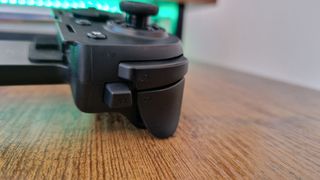
The Wolverine family’s circular D-pad feels so familiar it may have been ripped straight from Razer’s other controllers, and the thumbsticks are truly full-sized. Annoyingly, they aren’t Hall Sensor ones, which feels like a drawback for the money you spend, especially when GameSir includes them for cheaper. They’re also offset (or asymmetrical), which, might be the trend, but for handheld platforms, I’m personally not sure how long they’ll remain the favorite. The CRKD Nitro Deck+ has bucked the offset trend, and the Scuf Nomad is following suit.
Going against the latest Bluetooth connection trend though, the Kishi Ultra connects to an Android or Apple device using USB-C. The G8’s pivoting connector has well and truly spoiled me because even with the Kishi Ultra’s larger form factor, the rigidity of the USB-C component is a flaw to me. Luckily, there are various rubber stoppers in the Kishi Ultra’s box which means you can slot a myriad of devices into it, and you won’t need to take your phone in and out of its case for compatibility.
Not that I’m throwing side-eye at the Backbone One there at all.
Features
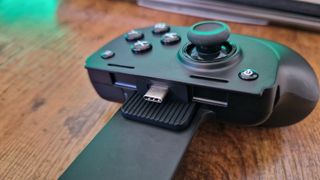
I don’t know what Razer has against back buttons, but they feel like a glaring omission from the Kishi Ultra I’m quite sad about. Extra functionality is here in the form of additional bumpers which are just as tactile as the controller’s face buttons. Still, these really aren’t as versatile as back buttons would have been, and arguably take a lot more dexterity to use since your index fingers are already assigned to working bumpers and triggers. The benefit of back buttons is that you don’t need to move your fingers out of position to gain extra functionality, and back buttons would have been right at home on the Kishi Ultra’s chunky-feeling grips.
Like a lot of the best PS5 controllers, you’ll find a USB-C charging port and a 3.5mm headphone jack on the bottom of the Kishi Ultra. The pad also features some function buttons, including a home, options, and share button. Additionally, you can use these central buttons to map the extra bumpers.
In a first for mobile controllers I’ve tested, the Kishi Ultra features some nice ambient RGB as well. This adds a nice touch, but does slightly compromise the sleek all-black look. Luckily, the RGB can be dimmed if you want to be a low-profile gamer on the train without drawing too much attention. Or, you can customize the RGB since it's compatible with Razer Chroma RGB software.
The Kishi Ultra is also the first home for Razer’s new Sensa HD Haptic technology. We’ve seen this teased in a few product videos before, and even in a few chair cushions. In this controller, however, they help to evoke some more accurate feedback than standard rumble can. It’s a real shame there’s no PlayStation support because it would have been a really nice addition to remote play. Sadly, the blame probably lies at Sony’s door for that shortcoming though.
Performance
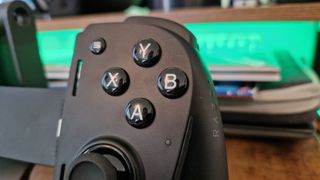
The Razer Kishi Ultra is one of those controllers that’s so close to the top of the field that I actually feel bad for not calling it my favorite. With its attributes, I think it’ll be a lot of people’s top pick for a mobile controller. Seeing other reviewers praise it with full marks and top spots on buying guides makes that clear, but for me, it comes up just shy of the mark.
For starters, I love using this thing for longer sessions. It is undoubtedly the most comfortable mobile controller out there, and that’s all down to the size and girth of the grips. It makes such a difference to mobile gameplay because even if its got asymmetrical sticks, the larger face means fewer thumb cramps. Running around in third-person games is where this felt best for me. Dungeons of Hinterbgerg controlled nice and smoothly, and I felt like I could be agile in combat thanks to the shoulder buttons not requiring me to move my thumb off the camera stick.
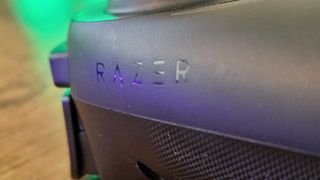
This is, however, where I started to notice the flaws of extra bumpers, as opposed to back buttons. They sit further in than the regular bumpers, and that means that reaching for them often means accidentally pressing the L1 and R1 buttons by proxy. It’s something you can adjust to with time, but in higher-pressure moments, it’s a design flaw that does rear its head.
First-person shooters were more fun than mobile controllers typically allow for thanks to the full-sized thumbsticks. Annoyingly, the deadzones were a tad large for my liking, making more precise aiming a bit difficult. Thankfully, while I was playing the WW1 Italian war front game Isonzo, the triggers came into their own. I also appreciated that you can slam them in and they remain pretty quiet - no loud plastic clacking noises to be heard. I particularly liked this because there have been a few times when I’ve been testing a mobile controller on the couch while my girlfriend reads a book, and the loud triggers on rival models have drawn me some library-esque looks of disdain.
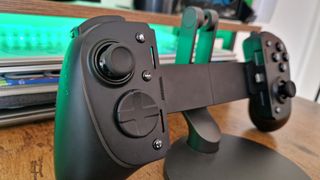
Unfortunately, the straw that broke the camel’s back was one of my go-to testing games for controllers on all platforms. Celeste is actually a fairly simplistic platformer mechanically speaking, but to succeed on its deadly mountain levels, you need precision above all else. I found using the Ultra’s extra bumpers often let me down. Granted, I did test them out on the game’s annoying windy section, but even so, I felt like the controller was offering me nothing in the way of precision. I’d say for anyone serious about using this controller for tricky platformers, think about another option. The face buttons did provide some nice tactility, and the haptics did mean each dash felt more subtle than a lot of rumbling gamepads do, so at least there’s that.
Overall, I am a big fan of this controller. It feels so comfortable to play with for longer sessions - moreso than I think any other mobile controller. Annoyingly, it just misses out on my top spot.
Should you buy the Razer Kishi Ultra
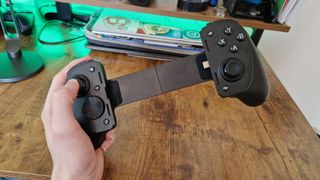
I think for anyone with larger hands especially, this is a mobile controller worth considering. If you hate the thumb pain you get from using smaller mobile pads, this is the one that makes it a thing of the past. If you mainly play third-person games, it’s a treat to use, and the Ultra’s design flaws are mitigated particularly in that genre. Moreover, if you have the money to splash out, or you’ve only ever liked the feel of Razer’s previous controllers, there’s a lot worth buying here. If you need something for long commutes, there really isn’t anything much better.
For me personally, the GameSir G8 Galileo hasn’t been kicked out of my backpack. It’s been close, but as a lover of ergonomic back buttons, I’ll always prefer the utility they give me over extra bumpers. I also tend to play a fairly wide genre of games, and since the G8 performed better across the board, not least in platformers, I think that’s what I’ll stick to.
I think for the money you pay, the G8 does offer more value; PlayStation Remote Play, the same sort of comfort, and now some increased compatibility thanks to a new Bluetooth model. All that, and the G8 costs well under $100/£100. Razer charging more than the competition for a gamepad is nothing new, but when rivals are so much cheaper, it becomes a tough sell.
How we tested the Razer Kishi Ultra
I put the Razer Kishi Ultra to the test for a little over a month before this review. In that time, I’ve used it as my only mobile controller and played a myriad of games on Xbox Game Pass with it. Some titles include Dungeons of Hinterberg, Celeste, EA Sports PGA Golf 2024, Senua’s Saga Hellblade 2, and Isonzo.
I compared my experiences closely with my time spent using a Backbone One controller, as well as other mobile controllers like the GameSir G8 Galileo and the Nacon MG-X. For more on how we test the latest gaming controllers, check out the full 12DOVE Hardware Policy.
For more gaming on the go, check out the best gaming handhelds, the best gaming laptops, and the best VR headsets.
One of my earliest memories is playing SuperMario64 and wondering why the controller I held had three grips, but I only had two hands. Ever since I've been in love with video games and their technology. After graduating from Edinburgh Napier University with a degree in Journalism, I contributed to the Scottish Games Network and completed an Editorial Internship at Expert Reviews. Over the last decade, I’ve been managing my own YouTube channel about my love of games too. These days, I'm one of the resident hardware nerds at 12DOVE, and I take the lead on our coverage of gaming PCs, VR, controllers, gaming chairs, and content creation gear. Now, I better stop myself here before I get talking about my favourite games like HUNT: Showdown, Dishonored, and Towerfall Ascension. Location: UK Remote

"30 years of history reside in our tape backups": PlayStation's building a game preservation mineshaft vault with 200 million files going back to a 1994 build of PS1 JRPG Arc the Lad

The other big Soulslike out this week has some Bloodborne and Dark Souls 3 in its combat, dev says, but "we would rather call AI Limit an action RPG"

The Last of Us showrunner says "so much" has happened in the five-year gap since we last saw Joel and Ellie: "That's part of the mystery of the season"
